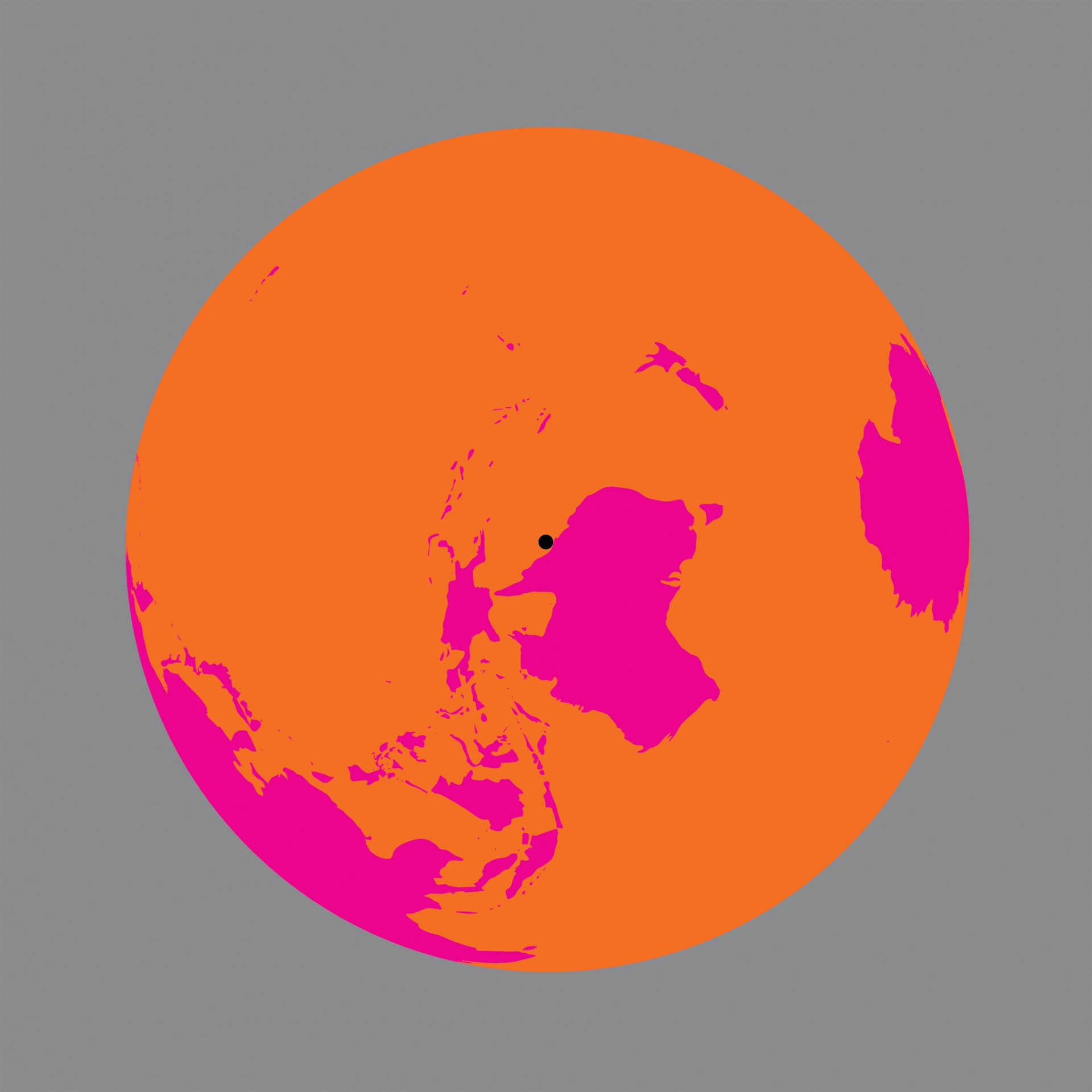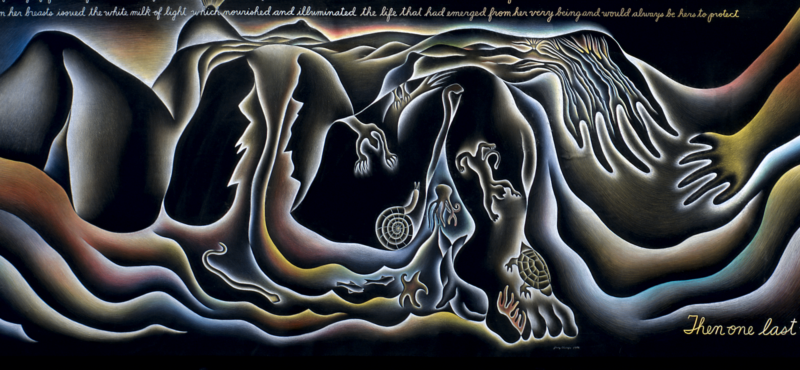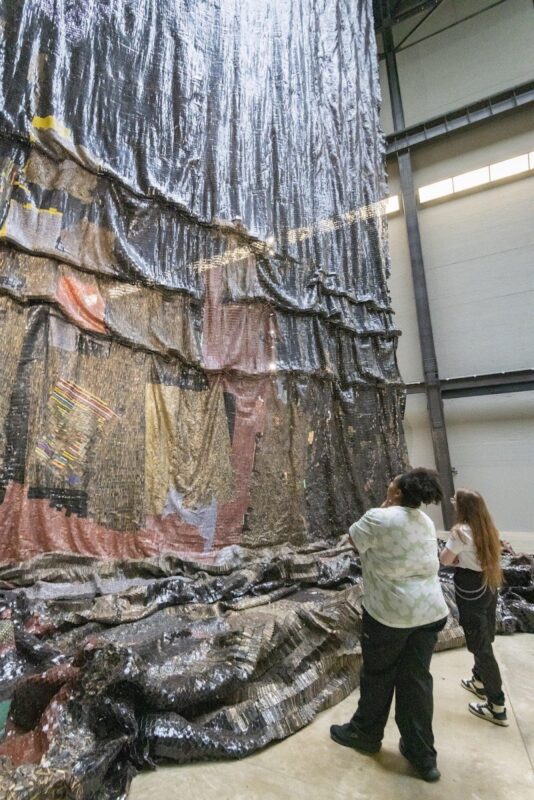
Olafur Eliasson, Earth perspectives, 2020 The Earth viewed over the Great Barrier Reef, Australia
Earth perspectives, a new participatory artwork by Olafur Eliasson, which invites people to reflect on the co-existence of multiple world views, launches today, Earth Day: Wednesday 22 April 2020.
Olafur Eliasson has created a series of nine images of the Earth, each of which has been abstracted by turning the planet on a different axis. Each image also denotes a particular spot on Earth with a “dot”. If a viewer stares at the dot for about ten seconds and then trains their focus onto a blank surface, an afterimage appears in the complementary colours of Eliasson’s visual – the viewer literally projects a new world view.
Olafur Eliasson said:
“Today, ‘the world as we know it’ is a phrase of the past. The current health crisis has brought our societies close to a halt, affecting our economies, our freedoms and even our social ties. We must take the time to empathise with all those struck by the crisis and also seize this opportunity to imagine together the earth that we want to inhabit in the future – in all its wonders and beauty, in the face of all the challenges ahead of us.
Earth perspectives envisions the earth we want to live on together by welcoming multiple perspectives – not only human perspectives but also those of plants, animals, and nature. A glacier’s perspective deviates from that of a human. The same goes for a river. On Earth Day, I want to advocate – as on any other day – that we recognise these various perspectives and, together, celebrate their co-existence.”
The first image will be unveiled at 10:00 BST on Instagram with eight further images posted subsequently every hour, each one a different view of the planet. The artwork will also be available for download at olafureliasson.net, serpentinegalleries.org and the Bloomberg Connects app.
The work explores how maps, space and the earth itself are all to a certain extent construction, which we all have the power to see from other perspectives, whether individually or collectively.
Olafur Eliasson’s relationship with the Serpentine dates to his commission for the Serpentine Pavilion made with Kjetil Thorsen in 2007 and his participation in the Experiment Marathon that autumn.
Hans Ulrich Obrist, Artistic Director and Bettina Korek, Chief Executive, Serpentine Galleries said:
“For our 50th anniversary programme, we have invited artists, thinkers, designers and architects from across the world to create works that respond to the climate emergency. Ecology is an integral component of the Serpentine’s history, and very much of our present, as well, as we now exist in a society adapting to a world changed by coronavirus. We must look to artists for guidance on how to shape the future and we are honoured that Olafur Eliasson has produced a new work for Back to Earth.”
Olafur Eliasson originally conceived one Earth perspective map for the magazine Real Review.
Sequence of posts for Earth Perspectives
The Earth viewed over the Great Barrier Reef, Australia
The world’s biggest single structure made by living organisms, now dying due to human activity and mass coral bleaching.
The Earth viewed over the Mariana Trench, Pacific Ocean
The deepest trench on Earth, reaching almost 11,000 meters below sea level. Despite its extremity, both living organisms and human-made plastics have been found at its bottom.
The Earth viewed over Yakutia, in Siberia, Russia
Rising temperatures are thawing permafrost in this remote region, deforming landscapes, releasing large quantities of methane, and disrupting animal migration patterns.
The Earth viewed over the Ganges River, India
A sacred waterway granted the same legal rights as a human being by an Indian court in 2017.
The Earth viewed over the Simien Mountains, Ethiopia
One of the rare places in Africa where snow falls regularly, this range is part of the Ethiopian Highlands, known as the ‘Roof of Africa’.
The Earth viewed over Chernobyl, in Pripyat, Ukraine
The site of the worst nuclear disaster in history, where rare and endangered species now thrive in the absence of humans.
7.
The Earth viewed over the Greenland ice sheet
A continent-wide ice sheet produced by falling snow over millions of years, now melting at staggering rates due to human-induced climate change.
8.
The Earth viewed over Ecuador
The first country in the world to recognize Rights of Nature in their Constitution, ratified in 2008. Nature has the ‘right to exist, persist, maintain and regenerate its vital cycles’.
The Earth viewed over the South Pole
The pole is at the heart of the virtually uninhabited continent of Antarctica, a vital ice-covered wildlife haven that is under threat from rapid warming and ice loss.
Social media
@serpentineuk
Twitter: @olafureliasson
Instagram: @studioolafureliasson
#EarthPerspectives
#BackToEarth
Categories
Tags
Related Posts

Yinka Shonibare’s first solo institutional exhibition in over 20 years.
Yinka Shonibare is back in London with his first solo institutional exhibition at Serpentine South in over 20 years featuring two new large-scale installations: Sanctuary City and War Library

Judy Chicago ‘Revelations’ will be the artist’s largest solo presentation in a London institution.
Serpentine will present the first major interdisciplinary, immersive institutional exhibition in London of Judy Chicago. Focused on drawing, it will bring together […]

The Top 5 Museum Exhibitions to see in London in March
Bottle tops, consumerism, Hello Kitty, takeaway boxes and Goliath.

Yinka Shonibare solo exhibition of new & recent works to open at Serpentine South.
Serpentine to present a solo exhibition of new and recent works by British Nigerian artist Yinka Shonibare (b. 1962, London, UK). […]
Trending Articles
 Turner Prize 2024 shortlist revealed on 40th anniversary. Tate Britain today announced the four artists who have been shortlisted for the Turner Prize 2024: Pio Abad, Claudette Johnson,…
Turner Prize 2024 shortlist revealed on 40th anniversary. Tate Britain today announced the four artists who have been shortlisted for the Turner Prize 2024: Pio Abad, Claudette Johnson,… National Portrait Gallery announces shortlist for Herbert Smith Freehills Portrait Award 2024 L-R: Zizi, 2023 by Isabella Watling © Isabella Watling; Jacqueline with Still Life, 2020 by Antony Williams © Antony Williams;…
National Portrait Gallery announces shortlist for Herbert Smith Freehills Portrait Award 2024 L-R: Zizi, 2023 by Isabella Watling © Isabella Watling; Jacqueline with Still Life, 2020 by Antony Williams © Antony Williams;… Antony Gormley’s Time Horizon, 100 life-size sculptures across 300 acres. Time Horizon, one of Antony Gormley’s most spectacular large-scale installations opens at Houghton Hall in Norfolk this Sunday 21st April
Antony Gormley’s Time Horizon, 100 life-size sculptures across 300 acres. Time Horizon, one of Antony Gormley’s most spectacular large-scale installations opens at Houghton Hall in Norfolk this Sunday 21st April Venice Biennale 2024 – Top 7 Padiglione Centrale Giardini | image by Andrea Avezzu, courtesy La Biennale di Venezia Stranieri Uvunque (Foreigners Everywhere) is the theme…
Venice Biennale 2024 – Top 7 Padiglione Centrale Giardini | image by Andrea Avezzu, courtesy La Biennale di Venezia Stranieri Uvunque (Foreigners Everywhere) is the theme…





